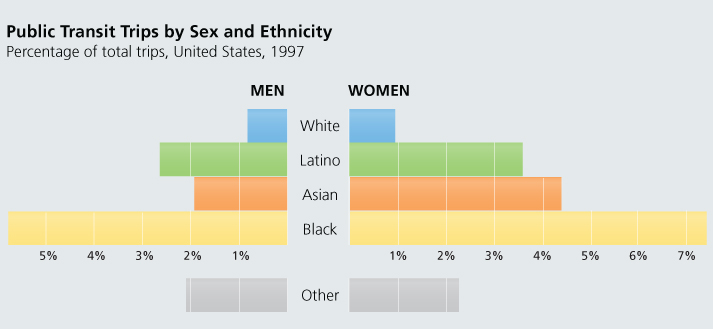Sex & Gender Analysis
Case Studies
- Science
- Health & Medicine
- Chronic Pain
- Colorectal Cancer
- Covid-19
- De-Gendering the Knee
- Dietary Assessment Method
- Gendered-Related Variables
- Heart Disease in Diverse Populations
- Medical Technology
- Nanomedicine
- Nanotechnology-Based Screening for HPV
- Nutrigenomics
- Osteoporosis Research in Men
- Prescription Drugs
- Systems Biology
- Engineering
- Assistive Technologies for the Elderly
- Domestic Robots
- Extended Virtual Reality
- Facial Recognition
- Gendering Social Robots
- Haptic Technology
- HIV Microbicides
- Inclusive Crash Test Dummies
- Human Thorax Model
- Machine Learning
- Machine Translation
- Making Machines Talk
- Video Games
- Virtual Assistants and Chatbots
- Environment
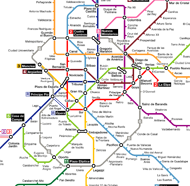
Public Transportation: Rethinking Concepts and Theories
The Challenge
Categories used in transportation surveys—and, hence, the way statistics are gathered and analyzed—may not properly account for caring work—that is unpaid labor performed by adults for children or other dependents, including labor related to the upkeep of a household. Public transport systems are typically designed around the needs of commuters (people traveling between their homes and places of paid employment). The mobility associated with caring work, including childcare and elder care, has typically not figured into transportation design.
Method: Rethinking Concepts and Theories
The innovative concept "mobility of care" provides a perspective for "recognizing and revaluing care work" (Sánchez de Madariaga, 2009). Incorporating "caring work" into user surveys helps to identify the significant number of trips that women and men make for this purpose. Understanding gender differences in public transportation is important for understanding climate change and planning efficient housing and neighborhoods.
Gendered Innovations:
- 1. Adding the concept, "mobility of care", to data collection variables may render public transportation more responsive to users' needs.
2. Understanding gender differences in travel has led to the concept of "trip chaining" with ramifications for the design of public transport systems.
3. Gathering data disaggregated by sex and other factors intersecting with sex and gender (such as income, family status, etc.) improves transportation research and policy.
Gendered Innovation 1: Visualizing the Mobility of Care
Method: Rethinking Language and Visual Representations
Gendered Innovation 2: Conceptualizing and Studying Trip Chaining
Method: Rethinking Concepts and Theories
Gendered Innovation 3: Gathering Sex-Disaggregated Data Improves Transport Policy and Research
Method: Intersectional Approaches
Conclusions
Next Steps
The Challenge
Researchers examining public transportation often categorize trips according to purpose in order to better understand existing transportation patterns and to better plan for infrastructure changes. For example, the U.S. Federal Highway Administration uses the following categories for public transit (U.S. FHA, 2009):
- ●To/From Work
●Related Business
●Shopping
●Other Family/Personal Errands
●School/Church
●Social and Recreational
●Other
Categories used in transportation surveys—and, hence, the way statistics are gathered and analyzed—may not properly account for caring work, i.e., unpaid labor performed by adults for children or other dependents, including labor related to the upkeep of a household.
Gendered Innovation 1: Visualizing the Mobility of Care
This gendered innovation is a summary of Ines Sánchez de Madariaga's research (2009, 2010, 2013a, 2013b). Time Use Surveys provide a perspective for evaluating transportation surveys. The Harmonised European Time Use Survey codes time use into forty-nine categories and provides sex-disaggregated data on time usage within fifteen countries. In Spain, women spend more time than men performing the three explicit categories of childcare coded in the Survey-
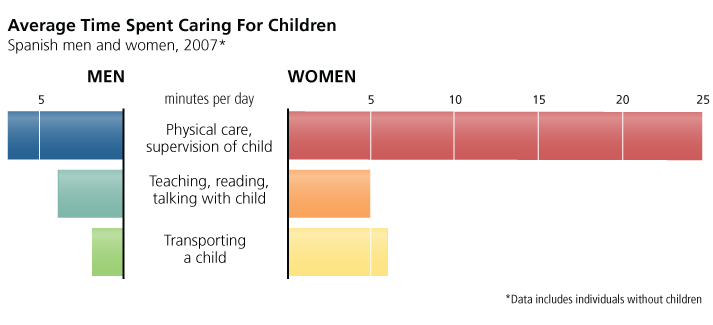
Data for Spain are similar to data averaged across the EU; in the 15 countries surveyed, women performed an average of 32 minutes of childcare per day, and men performed an average of 12 minutes. In all EU countries surveyed, women spent significantly more time performing childcare than men—from 1.7 times more in Sweden to 4.8 times more in Latvia. This pattern holds in the U.S. as well—in 2010, the average U.S. woman spent 32 minutes caring for and helping children in her household, twice as much as the average U.S. man's 16 minutes (United States Bureau of Labor Statistics, 2011). It is important to recognize that men's caring work has increased over time. Care-giving among British fathers, for example, increased nine-fold from 1961 to 1999 (O'Brien et al., 2003).
That women spend significantly more time than men performing caring work implies that consideration of caring work is a key to gender equality in transportation; many forms of caring work rely on public transportation.
Ines Sánchez de Madariaga's innovative concept, "mobility of care", provides a perspective for "recognizing and revaluing care work"—to appreciate the trips that women and men make when caring for others (Sánchez de Madariaga, 2009). Adding this concept to transportation surveys facilitates designing these trips into transit systems—see Method.
Method: Rethinking Language and Visual Representations
The innovative concept "mobility of care" reveals significant travel patterns otherwise concealed in data collection variables (Sánchez de Madariaga, 2013; Sánchez de Madariaga, 2009). The charts below represent public transportation trips made in Spain in 2007. The first chart (left) graphs transportation data as traditionally collected and reported. It privileges paid employment by presenting it as a single, large category. Caring work (shown in red) is divided into numerous small categories and hidden under other headings, such as escorting, shopping and leisure.
The second chart (right) reconceptualizes public transportation trips by collecting care trips into one category. Visualizing care trips in one dedicated category recognizes the importance of caring work and allows transportation engineers to design systems that work well for all segments of the population, improve urban efficiency, and guard against global warming (Sánchez de Madariaga, 2013).
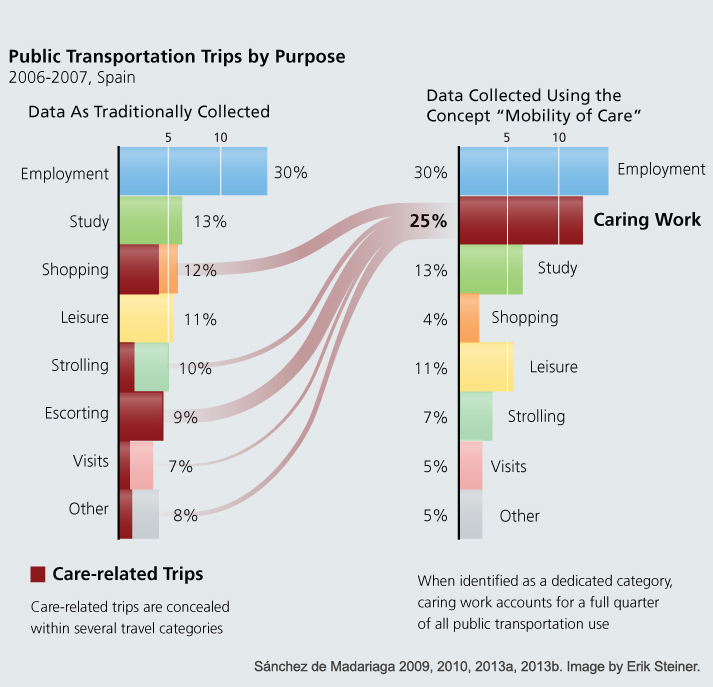
A number of innovations in transportation design have been implemented to support the mobility of care. In London, for example, these include:
● Step-free access to trains, subways, and buses. Transportation authorities are removing steps from streets to platforms to accommodate baby carriages, luggage, wheelchairs, and similar devices. By 2007, the London Underground had developed 47 step-free stations.
● Wide aisle gate access to transportation.
● Level access from platforms to trains (Transport for London, 2007).
Gendered Innovation 2: Conceptualizing and Studying Trip Chaining
A simplistic definition of a "trip" describes each trip as a journey from a single starting location to a single destination, typically using a single form of transportation. The concepts of "trip chaining" and "multipurpose trips" expand on this definition by recognizing that trips often involve a sequence of destinations and are multimodal (McGuckin et al., 2005b; Hanson, 1980). Research on trip chaining has examined the directions of trips, timing of travel, and purpose of the stops with attention to gender and other factors intersecting with sex and gender—see Methods below.
Method: Rethinking Concepts and Theories
Analyzing gender in transportation requires challenging underlying concepts and identifying gaps in the way data are collected. It also requires introducing new concepts and theories that model the complex routes taken by real people. A study of travel in the United States between 1995 and 2001 using the concept of trip chaining has produced the following insights regarding women's and men's travel patterns:
● A greater number of women than men make multiple-stop trips when traveling between their homes and workplaces. This difference between women and men is decreasing, however, mainly as a result of an increase in trip chaining among men (between 1995 and 2001, the number of stops men made while returning home from work increased by 24%).
● Women make more short stops on the way to or from work than do men to perform household-sustaining activities, such as shopping and family errands, and working women in two-worker families were twice as likely as men in two-worker families to pick up and drop off school-age children at school during their commute.
● Other demographic variables interact with gender in predicting trip chaining. For example, having a child under age 5 increases trip chaining by 54% for working women and 19% for working men—see chart (McGukin et al., 2005a).
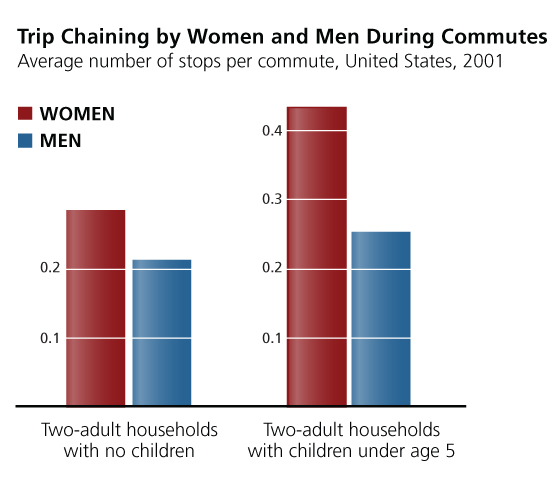
Research on trip chaining—with attention to gendered differences in travel—has been the key to urban development in Vienna, for example. When planning extensions to subway lines, civil engineers considered multi-destination trips involving travel to workplaces, crèches, schools, hospitals, and parks (Irschik, 2008).
Gendered Innovation 3: Gathering Sex-Disaggregated Data Improves Transportation Research and Policy
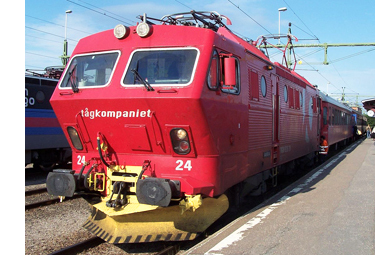 In 2001, officials in the Swedish Transportation Department acknowledged disparities between women and men in transportation sector employment (for example, most people in leadership positions were men, a form of vertical segregation) and proposed integrating gender analysis into Swedish transportation policy and administration practices (Sahlin et al., 2001). To advance the goal of creating "a gender-equal road transport system [….] that is designed to fulfill the transport needs of both women and men," researchers disaggregated transportation data by sex. Researchers found that, among people in paid employment, a greater proportion of women (18%) than men (14%) use public transit. Other differences were also observed.
In 2001, officials in the Swedish Transportation Department acknowledged disparities between women and men in transportation sector employment (for example, most people in leadership positions were men, a form of vertical segregation) and proposed integrating gender analysis into Swedish transportation policy and administration practices (Sahlin et al., 2001). To advance the goal of creating "a gender-equal road transport system [….] that is designed to fulfill the transport needs of both women and men," researchers disaggregated transportation data by sex. Researchers found that, among people in paid employment, a greater proportion of women (18%) than men (14%) use public transit. Other differences were also observed.
Subsequently, in planning a new commuter route project in Skane (Sweden's southernmost province), planners "prioritized routes that contributed to strengthening and developing local labour market regions for women, as these regions are geographically smaller, ahead of routes that expand the wider geographical labour market regions for men" (Swedish Road Administration, 2009). The Swedish Road Administration has also highlighted the need for a transit system to support gender equality, and its considerations include the reality that women "take more responsibility [than do men] for household work and caring for the young and elderly" (Swedish Road Administration, 2010).
Multiple EU projects funded under the Framework Programme 7 (FP7) use sex and gender analysis to enhance research. For example, the FP7 Transport Needs for an Ageing Society (TRACY) project gives "special attention to the gendered nature" of older people's transport needs (Gather et al., 2011).
Method: Intersectional Approaches
Disaggregating data by sex is a first step. To serve a wide user base, other variables need to be considered and analyzed for how they interact with sex and gender (Audirac, 2008). These include:
● Age: Designing public transport systems to consider the mobility needs of older adults supports safe mobility for older people who have ceased driving for various health reasons (Currie et al., 2010). Gender also interacts with age in the context of driving cessation: researchers found that "older females were more likely than males to have planned ahead [for cessation], made the decision themselves, and stopped at appropriate times" (Oxley et al., 2011). The correlation between age and geographic location is a serious challenge in supporting the mobility of older people; more older people live in rural areas than do younger people (O'Neill, 2010).
● Family status: The presence of children—particularly young children—increases the number of caring trips and the need for routes to accommodate these needs (Crane, 2007).
● Ethnicity: In the United States, use of public transportation differs by both sex and self-reported ethnicity. In all ethnic groups, women make a larger proportion of their trips via public transportation than do men. These sex differences, however, vary by ethnicity (see chart below produced with data from Doyle et al., 2000).
● Geographic location: Locations differ in safety. New design features have made transportation safer. These include designated waiting areas, transparent bus shelters, emergency intercoms and surveillance mechanisms, and alternative services and routes, such as request-stop programs that allow nighttime users to disembark from the bus at locations closer to their final destination at night (Schulz et al., 1996).Researchers working on the Framework Programme 7 (FP7) Growing Older, Staying Mobile (GOAL) project have created profiles of older people by analyzing gender alongside other factors, including demographic variables (age, financial resources, employment, etc.) and patterns of transit usage (Hoedemaeker et al., 2012).
Conclusions
Analyzing gender in public transportation requires:
- 1. Rethinking categories used in public transportation surveys. The innovative concept "mobility of care", captures significant travel patterns, and it can be used to render public transportation more equitable and responsive to users' needs.
2. Rethinking basic concepts, such as what constitutes a "trip"—whether to a single destination or a series of "chained"destinations.
3. Gathering data disaggregated by sex and other variables (such as income, self-reported ethnicity, family status, etc.) that may correlate with transit use.
Next Steps
The European Commission and other governmental organizations have identified how sex and gender analysis can enhance public transportation through both basic research and policymaking:
Basic Research:
- 1. Analyzing biological sex differences (in women's and men's height, weight, etc.) in designing steps and railings, positioning buttons, and other use factors. This analysis includes rethinking standards and reference models as necessary to recognize pregnancy as a normal physiological state (European Commission, 2007).
2. Collecting sex-disaggregated transportation data and including intersectional approaches (such as "socioeconomic and demographic indicators") in data analysis (European Commission, 2007).
Transport Policy:
- 1. Working to eliminate disparities between women's and men's representation on transit planning boards through efforts to increase the number of women experts in the transit work programme (European Commission, 2007).
2. Conducting regular and systematic "gender audits" to evaluate transport systems from a gender perspective (Hamilton et al., 2000).
3. Harmonizing transportation and time use statistics within the European Union in order to account for the mobility of care (European Parliament's Committee on Transport and Tourism, 2006).
Works Cited
Audirac, I. (2008). Universal Design and Accessible Transit Systems: Facts to Consider when Updating or Expanding your Transit System. Washington, D.C.: Project Action.
Crane, R. (2007). Is There a Quiet Revolution in Women's Travel? Revisiting the Gender Gap in Commuting. Journal of The American Planning Association, 73 (3), 298-316.
Currie, G., & Delbose, A. (2010). Exploring Public Transport Usage Trends in an Ageing Population. Transportation, 37 (1), 151-164.
Doyle, D., & Taylor, B. (2000). Variation in Metropolitan Travel Behavior by Sex and Ethnicity. In United States Federal Highway Administration (Ed.), Travel Patterns of People of Color: Final Report, pp. 181-244. Washington, DC: United States Department of Transportation.
European Commission. (2007). Women in Transport: First Progresses in FP7—Sustainable Surface Transport. Brussels: European Commission .
European Parliament's Committee on Transport and Tourism. (2006). Women and Transport Study, Provisional Version. Brussels: European Parliament.
Gather, M., Martin, J., Aragall., F., & Aslaksen, F. (2011). European Commission Project: Transport Needs for an Ageing Society.
Hamilton, K., & Jenkins, L. (2000). A Gender Audit for Public Transport: A New Policy Tool in the Tackling of Social Exclusion. Urban Studies, 37 (10), 1793-1800.
Hanson, S. (1980) Spatial Diversification and Multipurpose Travel: Implications for Choice Theory. Geographical Analysis, 12 (3), 245–257.
Harmonised European Time Use Survey (HETUS). (2007). Prepared Tables, Main Activities (2-Digit Level) by Sex and Country. Stockholm: Statistics Sweden Population and Welfare Statistics.
Hoedemaeker, M., Parik, M., Baldi, B., Qiao, Y., Sahr, C., & Nuñez-Fernández, F. (2012). GOAL: Profiles of Older People, First Draft.
Irschik, E. (2008). "Fair Shared City: Gender Mainstreaming Planning Strategy in Vienna, Austria", Proceedings of CaixaForum, November 17-18, Madrid.
McGuckin, N., & Nakamoto, Y. (2005a). Differences in Trip Chaining by Men and Women. In United States National Research Council, Research on Women's Issues in Transportation Report of a Conference, Vol. II: Technical Papers. Washington, D.C.: Government Publishing Office (GPO).
McGuckin, N., & Murakami, E. (2005b). Examining Trip-Chaining Behavior: A Comparison of Men and Women. Washington, D.C.: United States Department of Transportation.
O'Brien, M., & Shemilt, I. (2003). Working Fathers: Earning and Caring. Manchester: Equal Opportunities Commission.
O'Neil, D. (2010). Deciding on Driving Cessation and Transport Planning in Older Drivers with Dementia. European Geriatric Medicine, 1 (1), 22-25.
Oxley, J., & Charlton, J. (2011). Gender Differences in Attitudes to and Mobility Impacts of Driving Cessation. In Herbel, S., & Gaines, D. (Eds.), Women's Issues in Transportation: Summary of the Fourth International Conference, October 27-30, 2009, Irvine, California, Volume 2, pp. 64-73. Washington, D.C.: United States National Research Council (NRC) Transportation Research Board.
Sahlin, M., & Rosengren, B. (2001). Regeringens Proposition 2001/02:20— Infrastruktur för ett Långsiktigt Hållbart Transportsystem. Stockholm: Regeringskansliet.
Sánchez de Madariaga, I. (2013). The Mobility of Care: A new Concept in Urban Transportation. In Sánchez de Madariaga, I., & Roberts, M. (Eds.), Fair Share Cities: The Impact of Gender Planning in Europe. London: Ashgate.
Sánchez de Madariaga, I. (2009). Vivienda, Movilidad, y Urbanismo para la Igualdad en la Diversidad: Ciudades, Género, y Dependencia. Ciudad y Territorio Estudios Territoriales, XLI (161-162), 581-598.
Schulz, D., & Gilbert, S. (1996). "Women and Transit Security: A New Look at an Old Issue." Proceedings of the Women's Travel Issues Second National Conference, October 25-27, Baltimore.
Swedish Road Administration (SRA). (2010). The Road Transport Sector— Sectoral Report 2009. Stockholm: SRA.
Swedish Road Administration (SRA). (2009). The Road Transport Sector— Sectoral Report 2008. Stockholm: SRA.
Transport for London. (2007). Gender Equality Scheme. London: Group Publishing.
United States Bureau of Labor Statistics. (2011). American Time Use Survey—2010 Results. Washington, D.C.: United States Department of Labor.
United States Bureau of Labor Statistics, 2004). American Time Use Survey—2003 Results. Washington, D.C.: United States Department of Labor.
United States Federal Highway Administration. (2009). National Household Travel Survey (NHTS) Summary of Travel and Trends. Washington, D.C.: Government Publishing Office (GPO).
How can we create public transportation systems that best serve users' needs? Governments and civil engineers collect data to understand how people use trains, subways, and bus systems. The gendered innovation in this case study is reconceptualizing how data are collected. This case study summarizes research by Inés Sánchez de Madariaga (2009, 2010, 2013a, 2013b).
Traditionally, governments collect data in eight trip categories:employment, education, shopping, leisure, and the like (see image left). People who travel solely for employment tend to travel directly from home to work and back again.
None of these traditional trip categories captures caring work—caring for children, the elderly, or households. People who travel for employment plus caring work have different travel patterns. They tend to travel from home to daycare and on to work. Leaving work, they may stop at the food market, the dry cleaners, and daycare before returning home.

The chart on the right (above) shows what happens if you conceptualize "caring work" as a category in data collection. It becomes the second largest, and one that needs to be considered when designing travel routes.
Conceptualizing the "mobility of care" as a category of analysis creates more efficient transportation systems, reducing costs and enhancing the quality of life.


